SAVE 20% OFF 20% OFF Use Code NY26 *

Marquis Oral Paste Syringe (15% w/w ponazuril) (Single)
- Description
- Directions
- FAQ
- Reviews
Description
Marquis is the first FDA approved treatment for equine protozoal myeloencephalitis (EPM). Equine protozoal myeloencephalitis (EPM) is a common neurologic disease of horses living in the Americas. EPM is caused by the protozoa Sarcocystis neurona and leads to inflammation of the brain and spinal cord, resulting in various neurological deficits in horses such as abnormal gait, stumbling, falling and an inability to rise. The definitive host of EPM is the opossum, which sheds infective sporocysts of S. neurona that infect horses.
Marquis is an antiprotozoal oral paste approved by the FDA for the treatment of horses with EPM. It contains the active ingredient ponazuril which crosses the blood/brain barrier to reach the central nervous system. Once it has reached the central nervous system, ponazuril works to kill S. neurona to prevent the parasite from causing further damage.
Each mL of sterile aqueous solution contains:
Key Benefits
- FDA approved treatment for equine protozoal myeloencephalitis (EPM)
- Kills Sarcocystis neurona to prevent further damage to central nervous system
- Contains the active ingredient ponazuril
- Requires a veterinarian's prescription
- Provided as an oral paste
How It Works
Marquis contains an active ingredient called ponazuril, which fights against several life stages of parasites. It passes the blood/brain barrier, then reaches the horse's CNS (central nervous system), where it effectively kills parasites.
Indications
MARQUIS (ponazuril) is indicated for the treatment of equine protozoal myeloencephalitis (EPM) caused by Sarcocystis neurona.
Directions
View Marquis Drug Facts Sheet.
Dosage:
Administer MARQUIS at a dose of 15 mg/kg (6.81 mg/lb) body weight as a loading dose for the first dose only. The loading dose is followed by a maintenance dose of 5 mg/kg (2.27 mg/lb) body weight once daily for a period of 27 additional days.
Day 1: Administer a loading dose of 15 mg/kg (three times the maintenance dose) once by mouth. Because the dosage ring is calibrated by weight for the maintenance dose (5mg/kg), adjust the dosage ring to the appropriate weight and administer this 5 mg/kg dose orally, three consecutive times for a total dose of 15 mg/kg.
Day 2 through 28: Administer the maintenance dose of 5 mg/kg once daily by mouth.
Administration:
Paste syringe assembly:
Before administration, the syringe barrel and plunger require assembly. Ensure plunger is clean and dry.
- End cap must be on syringe barrel when inserting plunger.
- Carefully insert reusable plunger into base of syringe barrel until it snaps into place, then remove end cap and gently apply pressure to the plunger until paste is seen at the tip of the syringe barrel.
- Return end cap to tip of paste syringe.
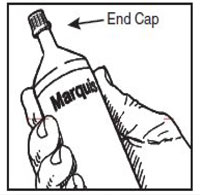
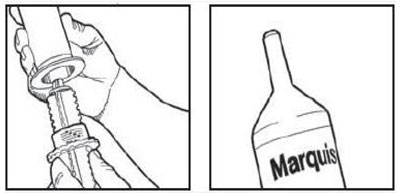
Administering MARQUIS to the horse:
NOTE: The paste syringe is a multi-dose package. Ensure that the correct dose is administered with each use.
- Remove end cap and gently apply pressure to the plunger until paste is seen at the tip of the syringe barrel. Return end cap to tip of paste syringe.
- Determine weight of horse and insure the horse's mouth contains no feed.
- To measure dose, dosage ring collar and barrel collar should be flush. Hold plunger and rotate dosage ring with the other hand to the weight of the horse.
- Remove end cap from tip of syringe barrel.
- The selected dose of paste should be deposited onto the back and top of the horse's tongue. Introduce tip of paste syringe into the side of the horse's mouth at the space between the front (incisor) and back (molar) teeth. Deposit paste on the horse's tongue by depressing the plunger of the syringe as far as the dose ring permits. Remove tip of syringe from horse's mouth.
- To aid swallowing of paste, immediately raise horse's head for a few seconds after dosing.
- Clean the tip of the syringe with a clean disposable towel and return end cap to tip of syringe barrel.
- For the next daily dose, repeat steps 1-7.
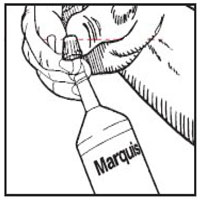
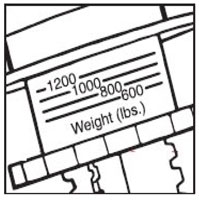
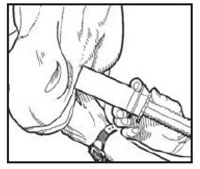
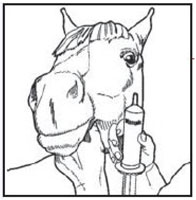
Caution:
Federal (U.S.A.) Law restricts this drug to use by or on the order of a licensed veterinarian.
Warning:
For use in animals only. Do not use in horses intended for human consumption. Not for human use. Keep out of the reach of children.
Precautions:
Prior to treatment, EPM should be distinguished from other diseases that may cause ataxia in horses. Injuries or lameness may also complicate the evaluation of an animal with EPM. In most instances, ataxia due to EPM is asymmetrical and affects the hind limbs.
Neurologic deficits, primarily ataxia, have been reported to acutely worsen during the early treatment period. In some horses the worsening of the neurologic deficits was transient. (See Post Approval Experience Section).
Clinicians should recognize that clearance of the parasite by ponazuril may not completely resolve the clinical signs attributed to the natural progression of the disease. The prognosis for animals treated for EPM may be dependent upon the severity of disease and the duration of the infection prior to treatment.
The safe use of MARQUIS in horses used for breeding purposes, during pregnancy, or in lactating mares, has not been evaluated. The safety of MARQUIS with concomitant therapies in horses has not been evaluated.
Adverse Reactions:
In the field study, eight animals were noted to have unusual daily observations. Two horses exhibited blisters on the nose and mouth at some point in the field study, three animals showed a skin rash or hives for up to 18 days, one animal had loose stools throughout the treatment period, one had a mild colic on one day and one animal had a seizure while on medication. The association of these reactions to treatment was not established.
Animal Safety Summary:
MARQUIS was administered to 24 adult horses (12 males and 12 females) in a target Animal safety study. Three groups of 8 horses each received 0, 10, or 30 mg/kg (water as control, 2X and 6X for a 5 mg/kg [2.27 mg/lb] dose). Horses were dosed after feeding. One half of each group was treated for 28 days and the other half for 56 days followed by necropsy upon termination of treatment. There were several instances of loose feces in all animals in the study irrespective of treatment, sporadic inappetence and one horse at 10 mg/kg (2X) lost weight while on test. Loose feces were treatment related. Histopathological findings included moderate edema in the uterine epithelium of three of the four females in the 6X group (two treated for 28 days and one for 56 days).
Storage:
Store at 20-25°C (68-77°F), excursions permitted between15-30°C (59-86°F).
FAQ
Features of Marquis:
- Offers effective equine protozoal treatment
- Kills many life stages of parasites
- Reaches the central nervous system
- Protects horses from sarcocystis neurona, which leads to equine protozoal myeloencephalitis (EPM)
Certain horses have experienced:
- Seizures
- Mild cases of colic
- Loose stools (only during treatment)
- Hives, skin rash, mouth blisters, or nose blisters for as many as 18 days


